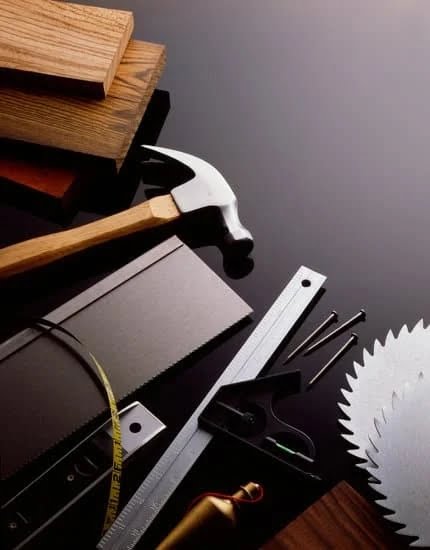Woodworking Workshop Tools are essential for anyone looking to pursue the craft of woodworking. Whether you are a professional carpenter or a DIY enthusiast, having the right tools is crucial to creating high-quality and durable wood products. In this article, we will explore the significance of investing in quality woodworking workshop tools and how they can impact the outcome of your projects.
When it comes to woodworking, having the right tools can make all the difference. From hand tools such as chisels and hand saws to power tools like drill presses, table saws, and sanders, each tool serves a specific purpose in creating precise and intricate woodwork. Additionally, having the appropriate protective gear is also essential for ensuring safety in the workshop.
In this comprehensive guide, we will delve into the different types of woodworking workshop tools and their functions. We will also discuss how to choose the right wood for different projects and provide tips on maintaining your tools for longevity and efficiency.
Furthermore, we will take a look at emerging technologies and innovations shaping the future of woodworking workshop tools. Whether you are a seasoned woodworker or just starting out, this article aims to equip you with the knowledge needed to make informed decisions about your woodworking tools and techniques.
Essential Hand Tools for Woodworking
The foundation of any woodworking workshop is a solid collection of essential hand tools. Chisels and hand saws are crucial for any woodworker, regardless of skill level or the size of their projects. A quality set of chisels allows for precise and delicate carving, while hand saws are ideal for making accurate cuts without the need for power tools.
Chisels come in a variety of sizes and shapes, each serving its own purpose in the woodworking process. From paring chisels for fine trimming to mortise chisels for creating joints, having a well-rounded collection is vital. Additionally, it’s important to keep these tools sharp using sharpening stones or honing guides to ensure optimal performance.
Hand saws are another staple in woodworking workshops, with options such as crosscut saws for cutting across the grain and rip saws for cutting along the grain. Back saws provide even more precision with their rigid back that prevents flex during use. These hand tools not only offer versatility but also allow woodworkers to develop their skills and craftsmanship without solely relying on power tools.
When it comes to crafting high-quality wooden pieces, investing in top-notch woodworking workshop tools is essential. Hand tools play a crucial role in the woodworking process, offering precision, control, and versatility that power tools simply cannot match. Whether you’re just starting your woodworking journey or looking to expand your tool collection, understanding the importance of these essential hand tools is key to achieving outstanding results.
| Woodworking Hand Tools | Description |
|---|---|
| Chisels | Precise carving and shaping tool available in various sizes and shapes. |
| Hand Saws | Versatile cutting tool allowing accurate cuts without reliance on power equipment. |
| Sharpening Stones/Honing Guides | Necessary tools for keeping chisels and hand saws sharp for optimal performance. |
Power Tools Every Woodworker Needs
When it comes to woodworking, power tools can significantly increase efficiency and precision in your projects. From drilling holes to shaping wood, having the right power tools is essential for any woodworker. Here are some of the essential power tools every woodworker needs in their workshop:
- Drill Press: A drill press is a must-have tool for any woodworking workshop. It allows for precise drilling and accurate hole placement, making it ideal for tasks such as doweling, mortising, and drilling repetitive holes.
- Table Saw: A table saw is one of the most versatile and essential power tools in woodworking. It can be used for ripping large sheets of wood, cutting boards to size, and creating various joinery techniques.
- Sanders: Sanders come in various forms such as belt sanders, orbital sanders, and disc sanders. These power tools are essential for finishing and smoothing out rough edges or surfaces on your woodworking projects.
Investing in high-quality power tools not only ensures a smoother workflow but also improves the overall quality of your woodworking projects. When using these power tools, it’s crucial to adhere to safety guidelines and wear appropriate protective gear.
Proper maintenance of your power tools is also important for longevity and efficiency. Regular cleaning, lubrication, and blade sharpening will prolong the life of your power tools and ensure optimal performance for years to come. As technology continues to advance, new innovations in woodworking workshop tools are constantly emerging. From improved safety features to enhanced automation capabilities, the future of woodworking power tools holds promising developments for woodworkers around the world.
Safety First
Woodworking can be an incredibly rewarding and fulfilling hobby or profession, but it also comes with its own set of risks. It’s essential to prioritize safety in any woodworking workshop, and this starts with having the right protective gear. Whether you’re a beginner or a seasoned woodworker, wearing the appropriate protective equipment is crucial for preventing accidents and minimizing the risk of injury.
Eye Protection
One of the most important pieces of protective gear for woodworking is eye protection. When working with woodworking workshop tools such as chisels, saws, and sanders, there is always a risk of flying debris and wood chips. Therefore, wearing safety glasses or goggles is non-negotiable. Look for eyewear that provides both impact protection and shields your eyes from dust and debris.
Hearing Protection
Woodworking often involves using power tools that generate high levels of noise, such as table saws and routers. Prolonged exposure to this noise can lead to hearing damage over time. To protect your hearing, invest in a pair of earmuffs or earplugs designed specifically for woodworking. These will help reduce the impact of loud noises on your ears while allowing you to work comfortably.
Respiratory Protection
Wood dust can be harmful if inhaled regularly over an extended period. To protect yourself from inhaling fine particles when sanding or cutting wood, use a respirator or dust mask. Look for respiratory protection equipment that is rated for filtering out wood particles, as well as any other potential airborne hazards present in your workshop environment. Proper respiratory protection is essential for maintaining good lung health while woodworking.
Organizing Your Workshop
Proper organization and storage of woodworking workshop tools are crucial for a safe and efficient working environment. With a wide variety of hand tools and power tools necessary for any woodworking project, it is important to have an organized system in place to ensure easy access and proper maintenance of these tools.
One key aspect of organizing a woodworking workshop is the storage of hand tools such as chisels, hand saws, planes, and measuring tools. Utilizing wall-mounted tool racks, pegboards, or tool chests can help keep these tools easily accessible while also protecting them from damage.
When it comes to power tools like drill presses, table saws, and sanders, proper storage is essential not only for the longevity of the tools but also for safety purposes. Investing in sturdy shelving units or cabinets specifically designed to hold power tools can help prevent accidents and damage to the equipment.
Additionally, it’s important to consider the layout of your workshop when organizing tool storage. Placing frequently used tools within arm’s reach of your workbench can save time and make the overall woodworking process more efficient. By implementing a well-thought-out storage solution for your woodworking workshop tools, you can create a safer and more productive workspace.
| Tool | Storage Solution |
|---|---|
| Chisels | Wall-mounted tool rack |
| Hand saws | Pegboard |
| Drill press | Sturdy shelving unit or cabinet |
| Table saws | Cabinet specifically designed for power tool storage |
Choosing the Right Wood for the Job
When it comes to woodworking, choosing the right type of wood for your project is essential. Different types of wood have unique characteristics and properties that make them suitable for specific applications. Whether you’re building furniture, crafting cabinets, or creating intricate woodwork, understanding the different types of wood available will help you achieve the best results.
To guide you in selecting the right wood for your woodworking project, here are some popular types of wood commonly used:
- Maple: Known for its strength and durability, maple is a popular choice for furniture making and flooring.
- Oak: With its prominent grain patterns and resistance to moisture, oak is often used for cabinets, flooring, and trim work.
- Cherry: Cherry wood is valued for its rich color and smooth finish, making it ideal for high-end furniture and decorative pieces.
- Mahogany: Renowned for its beauty and stability, mahogany is favored for fine furniture making and boat building.
In addition to these popular choices, there are many other types of wood that vary in characteristics such as hardness, grain pattern, and color. Some other notable woods include walnut, pine, cedar, birch, and teak. Each type of wood offers unique advantages depending on the specific requirements of your project.
Understanding the properties of different types of wood will help you make informed decisions when selecting materials for your woodworking projects. The right choice of wood can enhance the aesthetics and functionality of your creations while showcasing your skills as a craftsman using quality woodworking workshop tools.
Maintaining Your Woodworking Tools
Regular Cleaning and Inspection
Regular maintenance of woodworking workshop tools is essential to ensure their longevity and efficiency. One of the most basic yet crucial tips for maintaining your tools is to keep them clean and inspect them regularly.
Sawdust, dirt, and debris can build up on hand tools and power tools, affecting their performance and potentially causing damage over time. By regularly cleaning your tools after use and inspecting them for any signs of wear or damage, you can catch potential issues early and prevent costly repairs or replacements.
Proper Storage
Another important aspect of maintaining woodworking workshop tools is proper storage. Storing your tools in a dry, climate-controlled environment will help prevent rust and corrosion, which can significantly impact the performance and lifespan of your tools. Additionally, storing your tools in a designated space with proper organization will make it easier to find and access them when needed, reducing the risk of accidental damage from mishandling.
Sharpening and Calibration
Proper sharpening and calibration are key factors in ensuring the efficiency of woodworking workshop tools such as chisels, hand saws, drill bits, and planer blades. Regularly sharpening cutting edges and calibrating power tool settings will not only improve the quality of your work but also extend the lifespan of your tools.
Dull cutting edges can cause rough cuts and put unnecessary strain on both hand and power tools, leading to quicker wear and tear. By investing in quality sharpening equipment and following manufacturer’s guidelines for calibration, woodworkers can maintain their tools at peak performance levels for years to come.
The Future of Woodworking Workshop Tools
As technology continues to advance, the future of woodworking workshop tools holds incredible potential for innovation and improvement. From state-of-the-art power tools to advanced safety equipment, woodworkers can look forward to a wide range of exciting developments in the coming years.
One of the most anticipated advancements in woodworking workshop tools is the integration of smart technology. With the rise of IoT (Internet of Things), woodworkers can expect tools that are interconnected and able to communicate with each other, making it easier to track usage, monitor performance, and even receive maintenance alerts. This will not only improve efficiency but also contribute to a safer working environment.
Another area of innovation in woodworking workshop tools is sustainability. As the demand for eco-friendly practices grows, woodworkers can look forward to tools that are designed with environmentally conscious materials and processes in mind. For example, there is a movement toward more energy-efficient power tools and the use of sustainable materials in tool construction.
In addition, advancements in 3D printing technology offer exciting possibilities for custom tool design and production. Woodworkers will be able to create their own specialized woodworking workshop tools tailored to their specific needs and projects, further enhancing productivity and creativity in the workshop. As these emerging technologies continue to evolve, woodworkers can anticipate an exciting future filled with cutting-edge tools that improve both their craft and their overall work experience.
Frequently Asked Questions
What Tool Is Used in Wood Workshop?
The tool most commonly used in a wood workshop is the table saw. It is versatile and can be used for various cutting tasks, making it an essential tool for any woodworking project.
What Is the Most Used Tool in a Wood Shop?
While there are many tools that are frequently used in a wood shop, the most commonly used one is likely the cordless drill. Its ability to drill holes and drive screws makes it indispensable for woodworking projects of all kinds.
What Is the Most Essential Woodworking Tools?
Some of the most essential woodworking tools include a chisel set, a hand plane, a measuring tape, and clamps. These tools are fundamental for shaping wood, ensuring accuracy in measurements, and holding pieces securely during assembly or gluing.

Hi everyone! I’m a woodworker and blogger, and this is my woodworking blog. In my blog, I share tips and tricks for woodworkers of all skill levels, as well as project ideas that you can try yourself.





